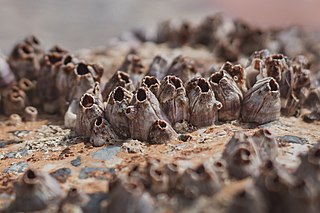
Balanus is a genus of barnacles in the family Balanidae of the subphylum Crustacea.

Thoracica is an infraclass of crustaceans which contains the most familiar species of barnacles found on rocky coasts, such as Semibalanus balanoides and Chthamalus stellatus. They have six well-developed limbs, and may be either stalked or sessile. The carapace is heavily calcified. The group includes free-living and commensal species.

The Balanidae comprise a family of barnacles of the order Balanomorpha. As a result of research published in 2021 by Chan et al., the members of the family Archaeobalanidae were merged with this family.

The Chthamalidae are a family of chthamaloid barnacles, living entirely in intertidal/subtidal habitats, characterized by a primary shell wall of eight, six, or four plates, lacking imbricating plate whorls, and either membraneous or more rarely calcareous basis. They are not found below immediate subtidal habitats, and more likely are found in the highest tier of shallow-water barnacle fauna. They can be found in the most rigorous wave-washed locations, and some species are found in the surf zone above high tide mark, only receiving water from wave action at high tide. The family includes at least 56 recognized species.

The Balanomorpha are an order of barnacles, containing familiar acorn barnacles of the seashore. The order contains these families:

Whale barnacles are species of acorn barnacle that belong to the family Coronulidae. They typically attach to baleen whales, and sometimes settle on toothed whales. The whale barnacles diverged from the turtle barnacles about three million years ago.

Alderflies are megalopteran insects of the family Sialidae. They are closely related to the dobsonflies and fishflies as well as to the prehistoric Euchauliodidae. All living alderflies – about 66 species all together – are part of the subfamily Sialinae, which contains nine extant genera.
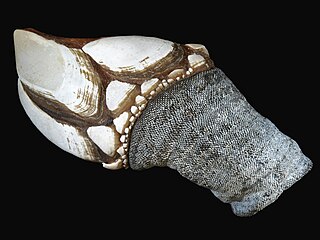
Pollicipedidae is a family of goose barnacles.

Pollicipes is a genus of goose barnacles, first described by William Elford Leach in 1817. It comprises four species of marine suspension-feeders.

Elminiidae is a family of symmetrical sessile barnacles in the order Balanomorpha. There are about 5 genera and 12 described species in Elminiidae.

Chelonibia is a genus of acorn barnacles in the family Chelonibiidae of the subphylum Crustacea. Its members are epizootic and live attached to manatees, turtles, marine molluscs, crabs and horseshoe crabs in all tropical and subtropical oceans. In a few instances, they have been found on sea snakes, alligators and inanimate substrates, but they are not found in the typical habitats of barnacles – on rocks, docks or boats.
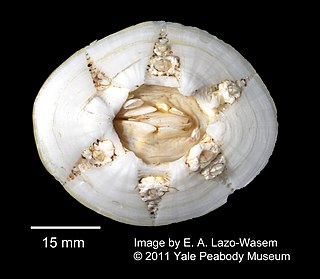
Chelonibiidae is a family of turtle barnacles in the order Balanomorpha. There are at least three genera and about eight described species in Chelonibiidae.
The Catophragmidae are a family of barnacles in the superfamily Chthamaloidea with eight shell wall plates, surrounded by several whorls of imbricating plates. The basis is membranous.

Scalpellidae is a family of acorn barnacles in the order Scalpellomorpha. There are about 25 genera and 220 described species in Scalpellidae.
Iblidae is a family of crustaceans belonging to the order Iblomorpha. There are two genera in the family, each with its own subfamily.
Lithoglyptida is an order of barnacles in the class Thecostraca. There are 2 families and more than 40 described species in Lithoglyptida.
Iblomorpha is a small order of barnacles in the class Thecostraca. There are only two families and about eight described species in Iblomorpha. In this group we find barnacles that use calcium phosphate in their shell, and species that protect themselves against predators with poison.
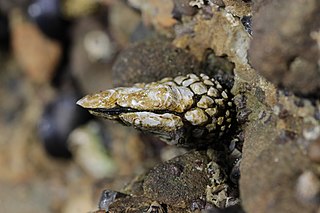
Pollicipedomorpha is an order of pedunculated barnacles in the class Thecostraca. There are 3 families and more than 30 described species in Pollicipedomorpha.
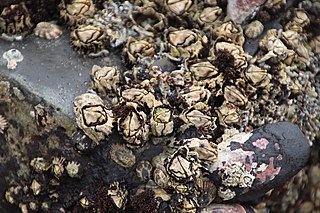
Octomeris is a genus of star barnacles in the family Chthamalidae. There are at least three described species in Octomeris.













